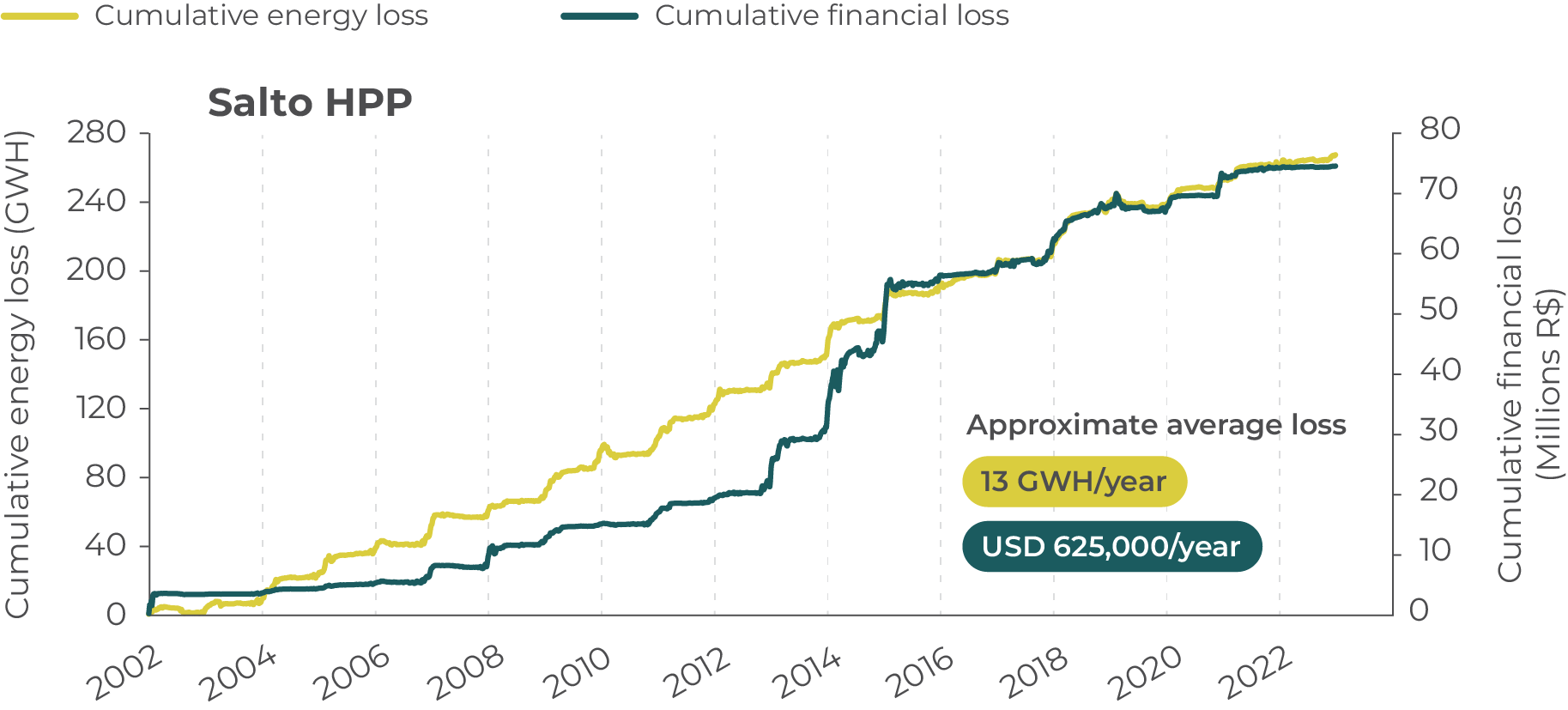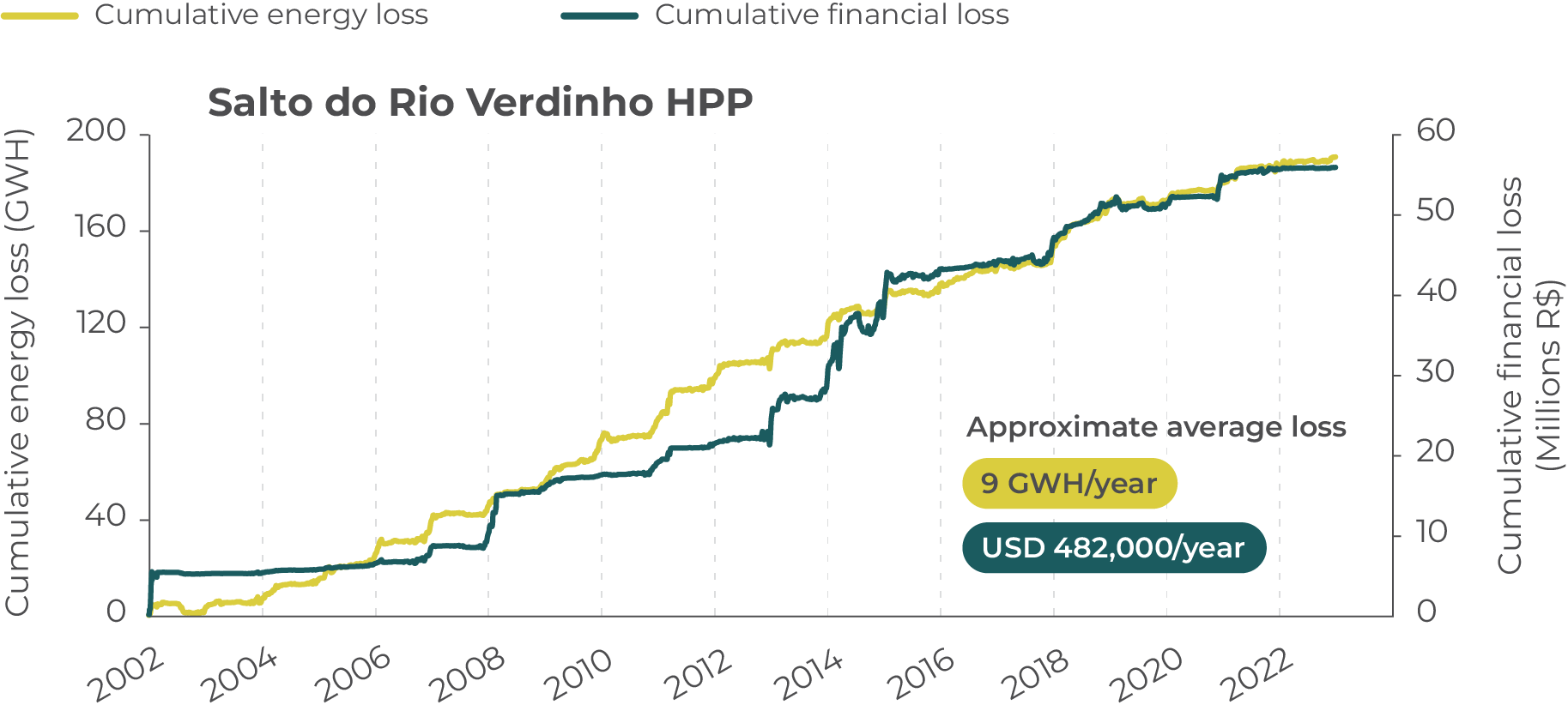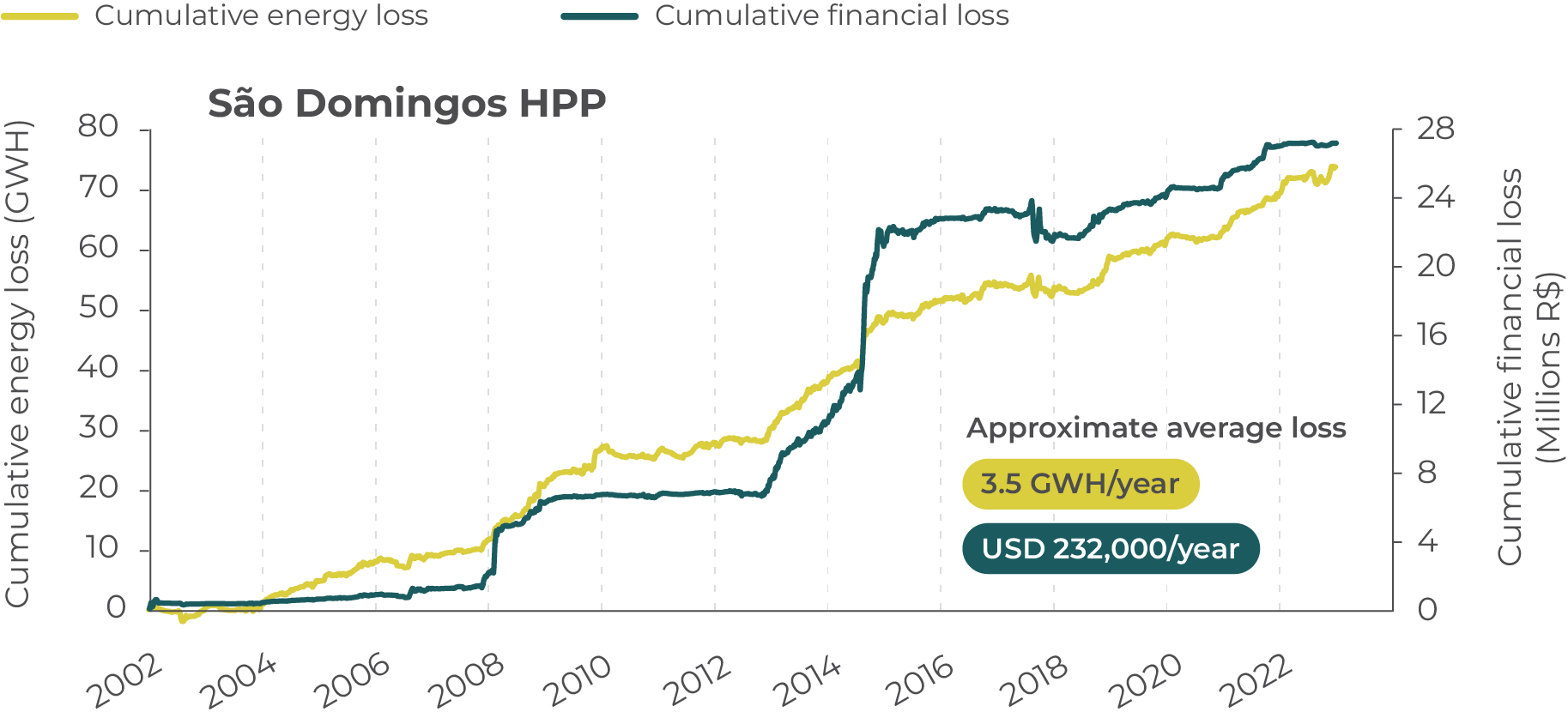The Amazon rainforest plays a crucial role in the global climate agenda and the Brazilian economy. It has a large carbon storage capacity and provides essential ecosystem services, including the regulation of rainfall patterns on a continental scale. The loss of forest vegetation negatively affects local biodiversity, the country’s economic development, and global climate stability.
Researchers from Climate Policy Initiative/Pontifical Catholic University of Rio de Janeiro (CPI/PUC-RIO) analyzed the impact of changes in rainfall patterns caused by deforestation on the country’s electricity generation. This study shows that deforestation in the Amazon negatively affects the country’s electricity generation capacity and revenue, even affecting hydropower plants (HPPs) located thousands of kilometers away from the Amazon biome.
By analyzing four of the most significant HPPs in the country, this publication explores the effects of deforestation on electricity generation both inside and outside of the Amazon region. The first case study, focusing on the Teles Pires HPP, located in the Amazon region, identifies that deforestation has reduced monthly generation by 2.5% to 10%, resulting in an annual revenue loss of USD 21 million for the hydroelectric plant.[1] The second case study investigates the impact of deforestation beyond the Amazon region. When analyzing the three HPPs in the Paraná Basin (located thousands of kilometers from the Amazon), researchers identified a generation loss of around 3%. For HPP Salto, for example, the electricity generation loss corresponds to a potential 10% loss of annual profit for the controlling company.
Hydroelectricity has historically been Brazil’s main source of electricity generation, accounting for 48.6% of installed capacity and 60.2% of total generation in 2023.[2] Hydroelectric power is a renewable source of energy that is economically competitive and brings operational flexibility to the electricity system. However, it is vulnerable to changes in rainfall patterns and hydrological regimes.
This study aims to highlight the connection between the Amazon rainforest and energy generation, demonstrating that the impacts of deforestation reach beyond the deforested area and affect national hydroelectric generation. This analysis hones in on the resilience of Brazil’s electricity mix, which is already facing water scarcity and increasingly frequent extreme weather events. Although this study focuses on two case studies, it raises the hypothesis that the reliability and availability of hydroelectric generation can be impacted by deforestation. In addition, the study identifies regions in the Amazon that contribute to the hydroelectric generation of the analyzed HPPs, as well as the land categories present in the areas of influence for each plant. By identifying the most relevant areas to hydroelectric generation, this analysis shows the priority areas for implementing conservation and restoration policies, which can guide the design of effective financial mechanisms and the targeting of public and private resources.
The results highlight the need to define strategies that reconcile conservation and restoration policies with those for energy generation, ensuring greater institutional integration between energy and environmental issues. Especially since a large part of Brazil’s power generation system is exposed to this mechanism—17 of the 20 hydroelectric plants with the highest capacity are in the path of the flying rivers.
Forest and Energy Generation: Quantifying the Flying Rivers
The phenomenon of flying rivers is defined in the literature as moisture-laden air currents that, from the Amazon, run east of the Andes in a north-south direction, carrying large amounts of moisture.[3],[4],[5],[6] Tropical forests recharge these air currents with moisture, producing a significant impact on rainfall patterns, which influences the water supply for energy production. The nexus between deforestation and energy generation loss, defined by Araújo, is illustrated in Figure 1.[7]
Figure 1. Nexus between Deforestation and Energy Generation Loss

Source: CPI/PUC-RIO, 2024
When deforestation occurs, the air currents that pass through deforested areas become less humid. The diminished humidity of these air currents reduces the incidence of rain along their routes. As a result, the water volume of rivers along the paths of the air currents is also reduced, which ultimately limits the hydroelectric generation capacity of the HPPs that they supply. The loss of forest vegetation, therefore, directly impacts the productivity of HPPs.
Figure 2 shows how air currents coming from the Atlantic Ocean cross the Amazon and pass through regions where a substantial number of Brazil’s HPPs are located, which are essential for supplying the national electricity system. Of the country’s 20 hydroelectric plants with the highest capacity, 17 are exposed to the flying river mechanism.
Figure 2. Brazilian Hydroelectric Power Plants and the Trajectory of the Winds
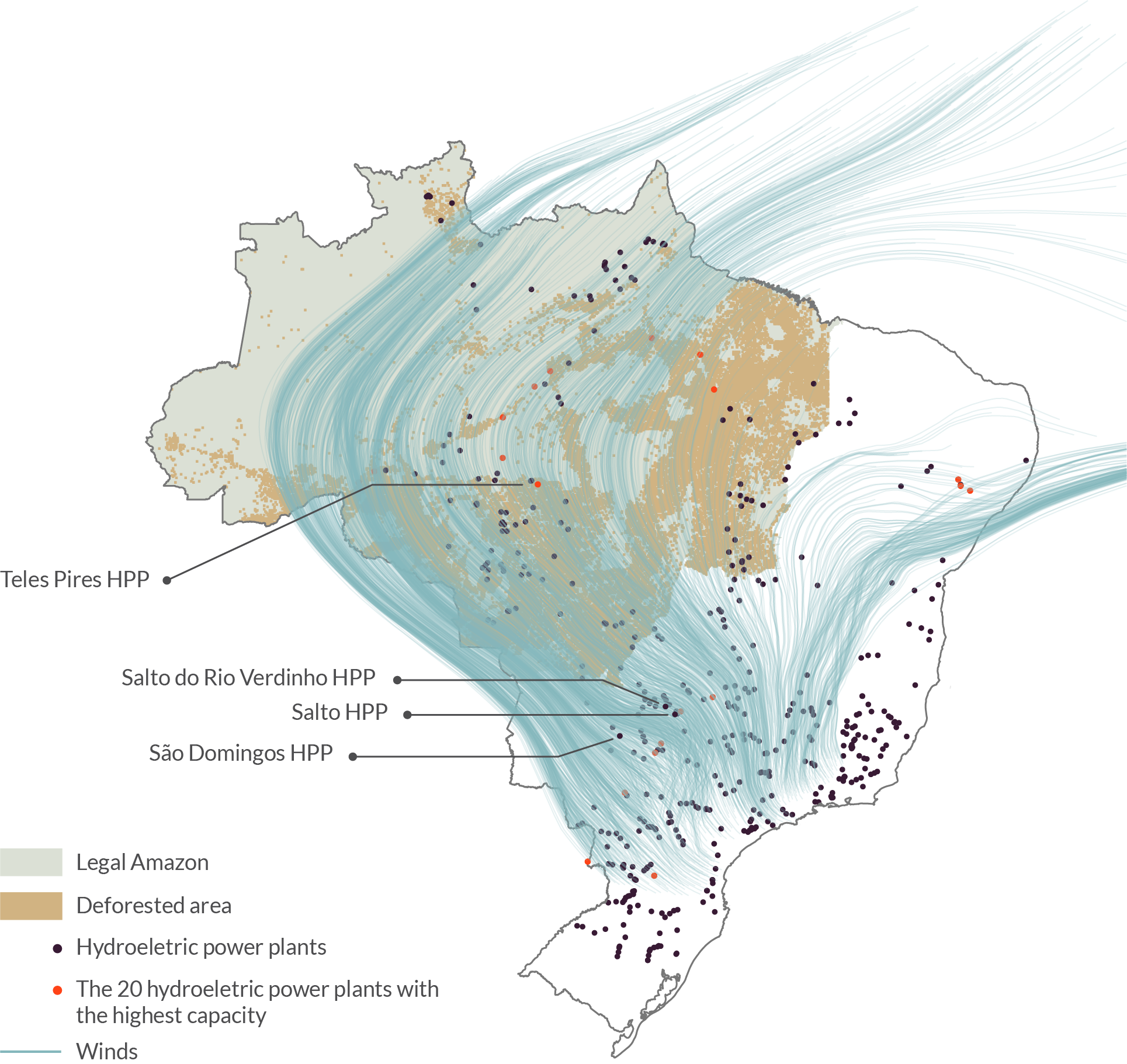
Source: CPI/PUC-RIO (2024) based on data from Copernicus-ERA5 (2023), MAPBIOMAS (2023), and ANEEL (2000)
Given the importance of hydroelectricity in Brazil’s electricity mix and the regions affected by the deforestation-energy generation nexus, a change in rainfall patterns due to deforestation could have a substantial impact on the country’s energy generation.[8],[9] This could lead to increased energy insecurity and raise the price of energy. It also has the potential to aggravate environmental issues if a drop in hydroelectric generation capacity leads to a an increase of fossil fuel-based thermoelectricity.
The Effects of Deforestation at HPP Teles Pires
The first case study analyzes the impacts on the Teles Pires HPP, located on the Teles Pires River, which runs between the states of Mato Grosso and Pará. The HPP was chosen because of its importance to the country’s energy generation. This plant began operating in 2015 and currently has an installed capacity of 1,820 MW, enough to supply a population of 13.5 million people.[10]
To estimate the influence of the Amazon forest on Teles Pires HPP’s power generation, this study took as a basis the approximately 690,000 km² of deforested land that has accumulated in the Amazon biome between 1985 and 2020. The method applied identifies the forest regions that impact the rainfall regime in the areas of influence for the power plant and then generates a hypothetical scenario without deforestation. This no-deforestation scenario is used to estimate the volume of rainfall that would have occurred in the areas of influence for Teles Pires HPP during the same period.[11]
Without deforestation in the region between 1985 and 2020, the plant would have had the capacity to generate, on average, between 2.5% and 10% more electricity than was observed.[12] The lost generation potential corresponds to the supply of electricity for at least 330,000 people. When considering the price of selling energy over the period (Differences Settlement Price), this loss in energy generation is equivalent to an average loss of USD 21 million per year for the plant. Considering that the loss of revenue is due to forest loss over the period, this figure may indicate the plant’s propensity to invest in the conservation of forest areas that are relevant to maintaining the flow of rivers that feed it.[13]
Figure 3 identifies a significant area that influences the power generation of Teles Pires HPP. This area has been partly deforested and partly conserved. The various trajectories of the tracked currents cross approximately 177.5 km² of deforested areas, indicating the importance of adopting restoration policies.
The estimated revenue loss of USD 21 million demonstrates that the area of Amazon forest that influences electricity generation at Teles Pires HPP has a monetary value, in perpetuity, of an average of USD 2,382/km². However, when focusing on the 5% area of forest most relevant to the plant’s power generation, the value of conservation rises to USD 6,000/km².[14]
Figure 3. Impact on Teles Pires HPP Generation
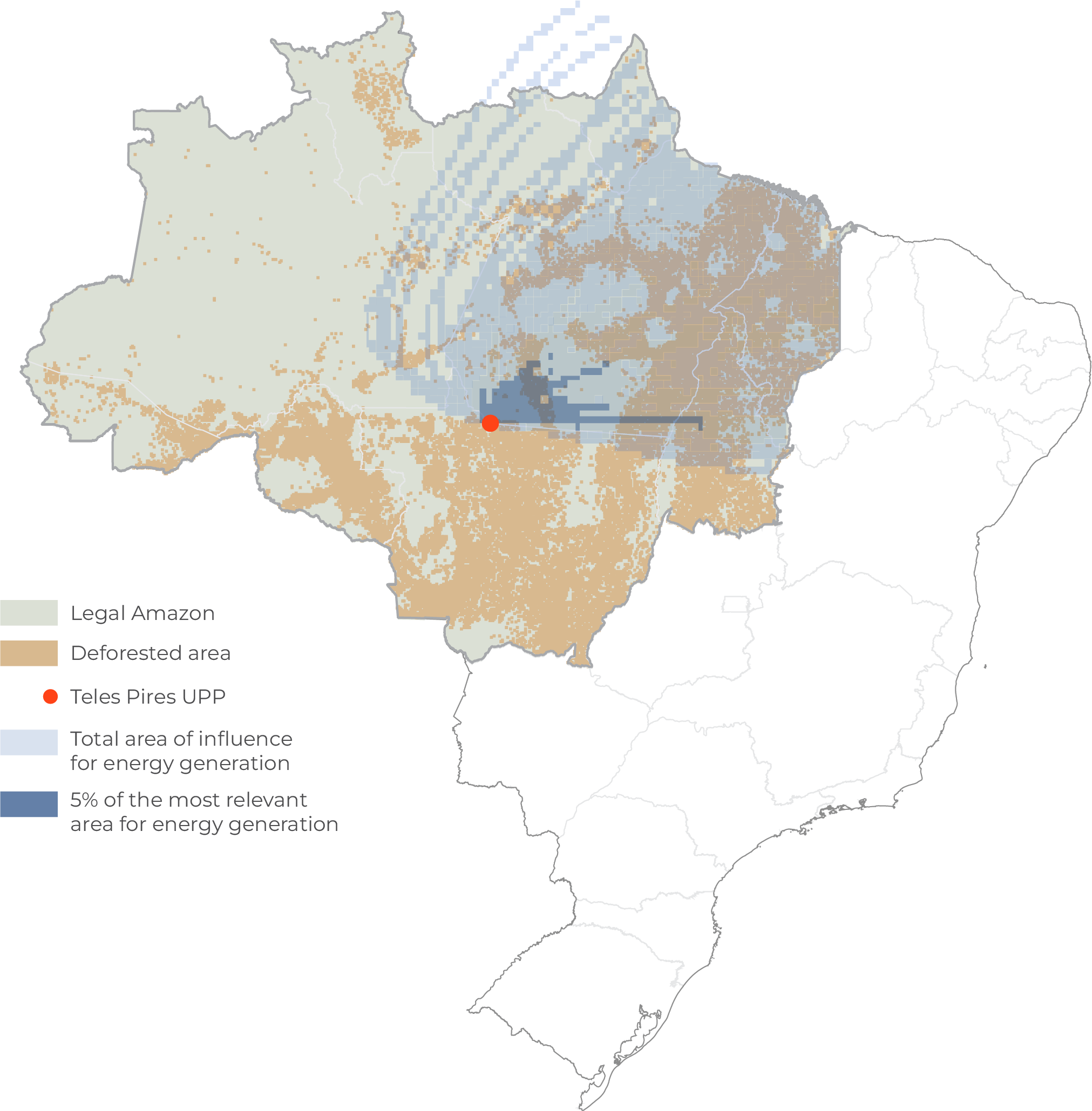
Source: CPI/PUC-RIO with data from Copernicus-ERA5 (2023), MAPBIOMAS (2023), SICAR (2023), SIGEF/INCRA (2023) and FUNAI (2023), 2024
Mapping the land tenure categories of the areas that affect the generation potential of the Teles Pires HPP is crucial for targeting policies to combat deforestation and developing effective mechanisms and instruments for conserving and restoring these areas. Indigenous land is the main land tenure category of the 25% of forest area that most influences electricity generation at the Teles Pires HPP, corresponding to 41.6% of that area. The next-largest land category is undesignated forest, accounting for 18.5% (Figure 4).
Figure 4. Distribution of Land Categories in Teles Pires HPP
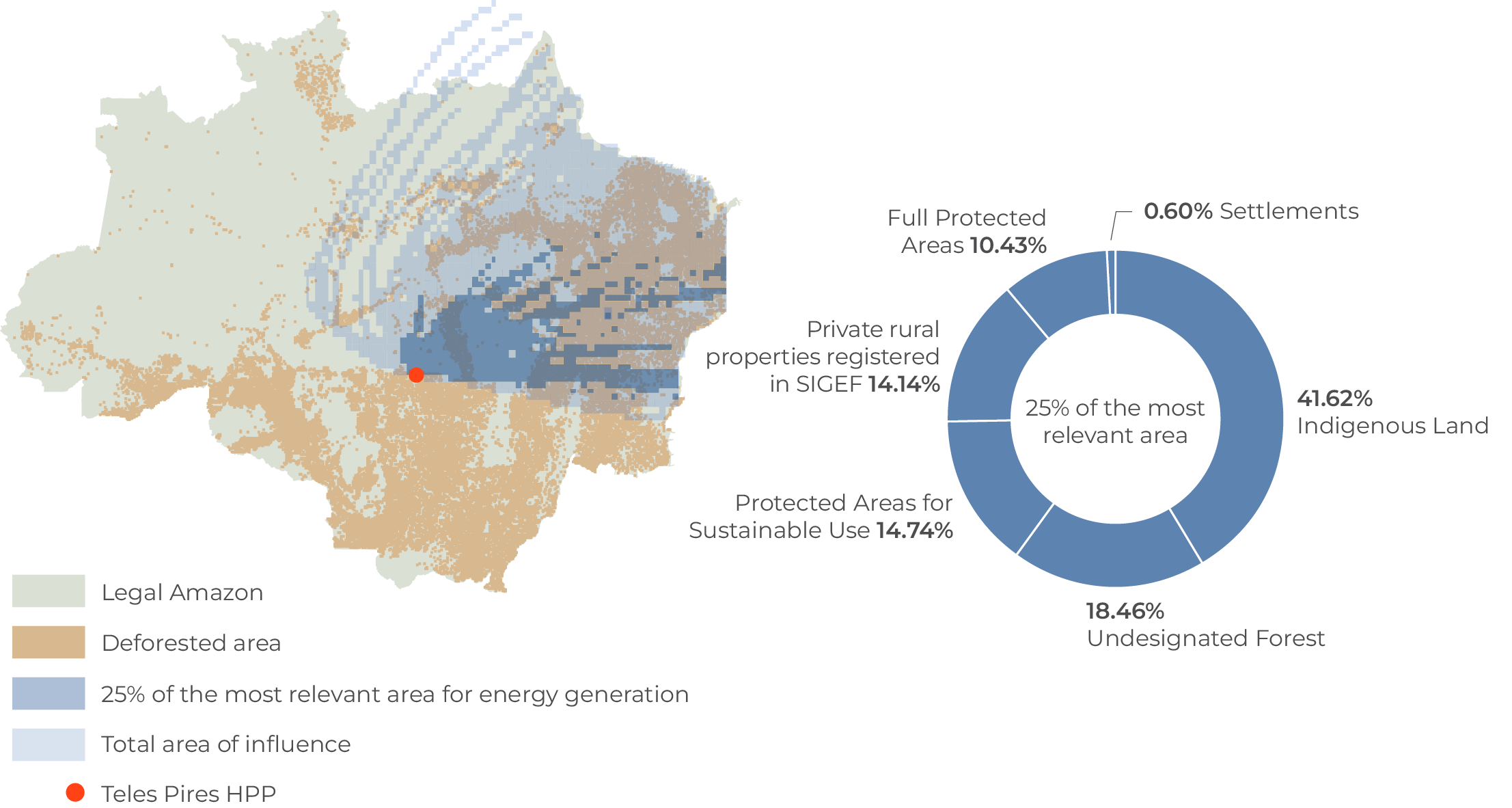
Source: CPI/PUC-RIO (2024) with data from Copernicus-ERA5 (2023), MAPBIOMAS (2023), SICAR (2023), SIGEF/INCRA (2023), and FUNAI (2023)
The Effects of Deforestation on HPPs in the Paraná Basin
The second case study applies the methodology adopted for Teles Pires HPP to the three hydroelectric plants in the Paraná Basin (Salto, Salto do Rio Verdinho, and São Domingos HPPs), highlighting the impact of Amazon deforestation beyond the biome.[15] These plants were selected based on two criteria: the relevance of the region to the country’s electricity supply and the fact that they are run-of-river plants—i.e., they do not have significant water storage capacity—which allows the direct effect of the river’s flow to be observed.
As shown in Figure 1, the three plants are located kilometers away from the Amazon biome, a relevant aspect for analyzing the extent of the effects of deforestation on power generation. The Salto and Salto do Rio Verdinho HPPs are located on the Verde River, in the state of Goiás, and have an installed capacity of 116 MW and 93 MW, respectively.[16],[17] The São Domingos HPP, also located on the Verde River, is in the state of Mato Grosso do Sul and has an installed capacity of 48 MW.[18],[19] The same methodology was adopted to assess the impact of deforestation on these plants as for Teles Pires HPP. As found in the first case study, the energy loss is a consequence of reduced river volume where the plants are located, due to the lower incidence of rainfall in the area resulting from the effects of deforestation.
Figure 5. Accumulated Losses in Energy Generation and Associated Revenue for Salto, Salto do Rio Verdinho, and São Domingos HPPs, 2002-2022
Source: CPI/PUC-RIO (2024), with data from Copernicus-ERA5 (2023), ONS (2023), CCEE (2023), and MAPBIOMAS (2023)
Figure 5 shows the accumulated losses of both generated energy and associated revenue for the period between 2002 and 2022, for Salto, Salto do Rio Verdinho, and São Domingos HPPs, respectively.[20] The accumulated loss in energy generation for the Salto HPP was 267 GWh, accounting for USD 13 million over this 21-year period. These figures correspond to an average annual loss of approximately 13 GWh/year and USD 625,000/year. In 2022, the plant’s generation was 453 GWh, with deforestation having caused an average reduction in generation capacity of approximately 2.8%.[21] Looking at the income statement of CTG Brasil S.A., the sole owner of Salto HPP, it shows that the installed capacity of the aggregate of controlled plants is 7,600 MW, of which 1.5% corresponds to Salto HPP.[22] The net profit for 2023 was approximately USD 482 million. Assuming that all the group’s plants suffer the same impact from loss of generation due to deforestation, the impact on net profit would be equivalent to approximately USD 41 million, or 8.7%.[23]
For the Salto do Rio Verdinho HPP, as Figure 5 shows, the losses identified are 190 GWh and USD 10 million. On an annual basis, these figures correspond to an average of 9 GWh/year and USD 482,000/year. For the São Domingos HPP, these figures are 74 GWh and USD 4.8 million, equivalent to 3.5 GWh/year and USD 232,000/year. Although detailed information on the productivity of these plants is unavailable, the losses are proportional to their respective installed powers, suggesting impacts similar to those found for Salto HPP.
As demonstrated above, the effects of deforestation in the Amazon rainforest are significant for HPPs in the Paraná Basin, generating a generation loss of 3% and a profit loss of 10%. The figures show that Amazon deforestation not only directly impacts the biome, but also has significant consequences for the entire Brazilian electricity system.
By focusing on the regions of the Amazon biome that most influence the hydroelectric generation of each plant, Figure 6 shows those with the greatest impact. More specifically, the value of the 5% most relevant forest area for power generation at the São Domingos, Salto and Salto do Rio Verdinho HPPs dams reaches USD 11/km², USD 25/km², and USD 19/km², respectively. It is important to note the difference in order of magnitude between these values and those found for the Teles Pires HPP, which is related to the size of the plants. The installed capacity of the Teles Pires HPP is more than 15 times greater than that of the Salto plant, the largest of the three Paraná Basin plants. In addition, the Teles Pires HPP is located in the Amazon biome, potentially giving the nearby forest regions greater influence over its operations compared to HPPs in the Paraná Basin.
An analysis of the land tenure for the most influential forest area for electricity generation in the Paraná Basin HPPs reveals that private rural properties, registered under Brazil’s Land Management System (Sistema de Gestão Fundiária – SIGEF) are the most important land tenure category in all the cases analyzed, with approximately 40% of the impact on the power plants, followed by indigenous lands, with approximately 20% (Figure 6).
Figure 6. Distribution of Land Tenure Categories for the Salto, Salto do Rio Verdinho, and São Domingos HPPs
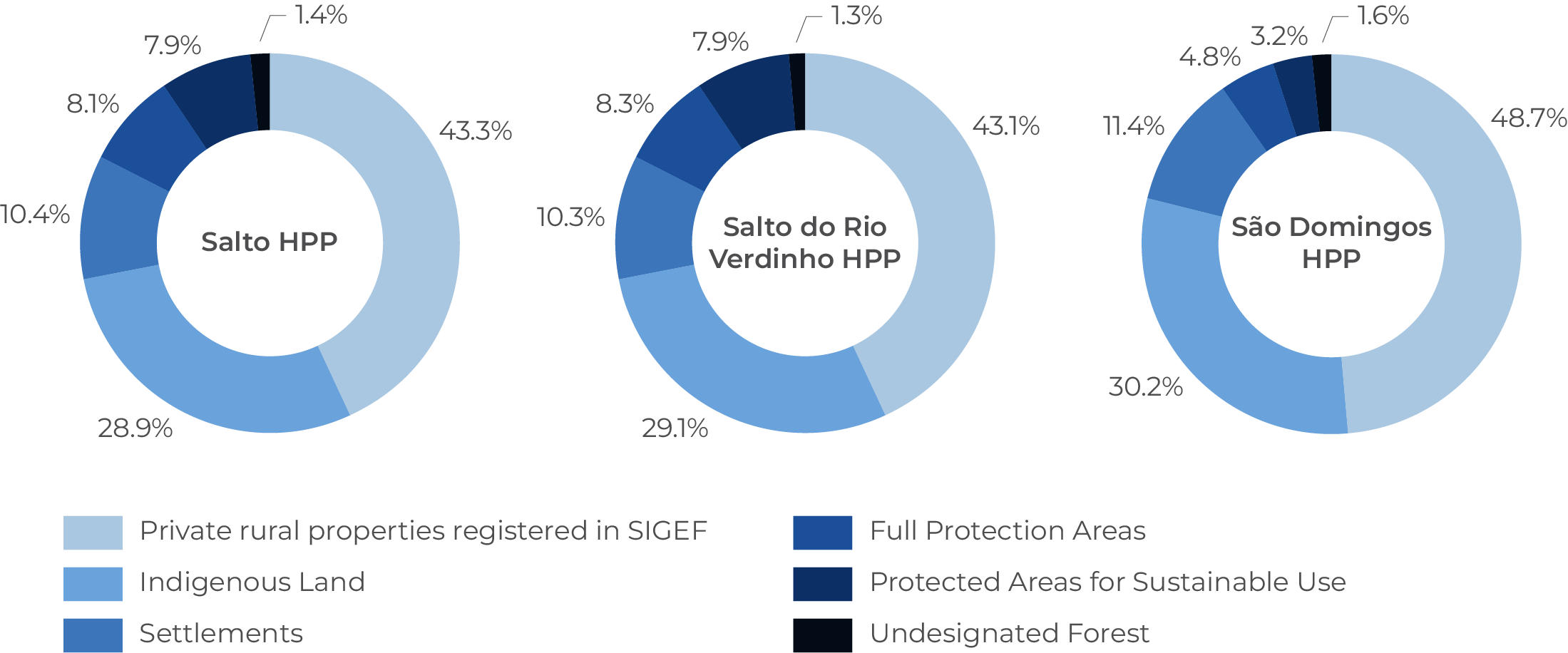
Note: The land distribution refers to the 25% of the area that is most relevant to each plant’s energy generation.
Source: CPI/PUC-RIO with data from Copernicus-ERA5 (2023), ONS (2023), CCEE (2023) e MAPBIOMAS (2023), 2024
Conservation and Restoration Mechanisms by Land Tenure Category
This study establishes a direct relationship between the role of the Amazon rainforest and the electricity generation potential of HPPs. In this context, identifying the land ownership categories of the areas of greatest interest is fundamental to identifying the most relevant public policies and finance instruments to help in the conservation and/or forest restoration of these areas.
The Amazon region is made up of a mosaic of land categories, including indigenous lands; protected areas; agrarian reform settlements; undesignated public forests; and private properties. With the exception of private properties, all of these land categories are in the public domain, so the public authorities play an important role in managing these areas. Essential bodies in command and control actions against illegal deforestation include the Brazilian Institute of Environment and Renewable Natural Resources (Instituto Brasileiro do Meio Ambiente e dos Recursos Naturais Renováveis – IBAMA), the Federal and State Police, the Army, and the National Public Security Force. In addition, areas may be either federal or state public domains, bringing an extra layer of complexity to land governance.
Indigenous lands are the most important land tenure category for the Teles Pires HPP and are also important for the HPPs in the Paraná Basin. Indigenous lands are controlled by the Federal Government, but with the exclusive use of indigenous peoples, who are directly responsible for the territorial and environmental management of their lands. Indigenous lands occupy very large areas, presenting a major challenge to protect them from illegal encroachment by third parties. For this reason, monitoring and inspection activities by the public authorities are essential for protecting the forest. In addition to command and control actions, the demarcation of indigenous lands and the Brazilian Policy for Territorial and Environmental Management of Indigenous Lands (Política Nacional de Gestão Territorial e Ambiental de Terras Indígenas – PNGATI) must be strengthened. Indigenous lands are the best-conserved areas, they shoulnefit from payment for environmental services programs, REDD+, and donations to guarantee their way of life and cultural reproduction.
Undesignated public forest is the second most relevant land tenure category for the Teles Pires HPP. These areas present a much greater management challenge, as without a specific designation, they are more vulnerable to land grabbing and illegal deforestation. Currently, the Technical Chamber for the Allocation and Land Regularization of Federal Rural Public Lands, under the coordination of the Ministry of Agrarian Development and Family Agriculture (Ministério do Desenvolvimento Agrário e Agricultura Familiar – MDA), is responsible for the allocation of federal areas, while state land agencies manage state areas. The conservation of forest areas will depend on their designation; those designated for private titling face a greater risk of deforestation for productive activities. In this context, sustainable rural development policies and financial instruments to guarantee conservation will be fundamental. The allocation of public lands for the creation of protected areas, land regularization for Traditional Peoples and Communities, and forest concessions for sustainable management or restoration could, in principle, ensure better conservation of the area.
Private rural properties, which are registered with SIGEF, appear to be the most important land tenure category for the Paraná Basin HPPs. Forest conservation and restoration in these areas depend on the implementation of the Forest Code, which imposes an obligation to conserve and/or restore liabilities in Permanent Preservation Areas (Áreas de Preservação Permanente – APPs) and Legal Reserves (Reservas Legais – RL). Special lines of finance for sustainable crops, including pasture management, agroforestry systems, and crop-cattle-forest integration can support a transition to a production model that is more aligned with conservation. In addition, economic instruments to conserve and restore the forest, such as payment for environmental services and the carbon market, will be key to encouraging not only compliance with the Forest Code, but also going beyond legal requirements.
Protected areas are the third most important land tenure category for both the Teles Pires HPP and the HPPs in the Paraná Basin. Policies and strategies for forest conservation and/or restoration in protected areas should be differentiated depending on whether they are full protection or sustainable use areas.
Full protected areas depend on command and control actions to combat deforestation. Restoration of deforested areas, on the other hand, can be done in partnership with the private sector through forestry concessions for restoration or other partnership models. In protected areas for sustainable use with a presence of Traditional Peoples and Communities and family farmers, forest conservation and restoration will depend not only on public conservation policies, but also on rural inclusion and sustainable production. Policies for providing technical assistance for the development of sustainable forestry product supply chains should be prioritized. In addition, mechanisms that reward conservation, such as PES, REDD+, and the carbon market, can also play an important role.
Finally, rural agrarian settlements are the least relevant land tenure category for the hydroelectric dams in this study, but they are still important in the Amazon context. Settlements can be divided into two categories: traditional settlement projects and environmentally differentiated settlement projects. Traditional settlement projects are divided into small plots that are occupied by family farmers. The Forest Code is the main conservation and restoration policy for these areas, but its implementation depends on assistance from public authorities. Rural inclusion and sustainable crop policies are also essential for aligning production with conservation. Environmentally differentiated settlement projects are similar to protected areas for sustainable use. They have much larger areas than the traditional settlement projects, and are mainly intended for Traditional Peoples and Communities. As a result, the same observations and recommendations that were mentioned for protected areas for sustainable use apply.
Implications for Public Policy
The results of this study indicate that the impacts of deforestation are not limited to within the borders of the Amazon biome but are also observed thousands of kilometers away from the region. The findings suggest that deforestation significantly influences the country’s hydroelectric generation capacity, a central and strategic asset for economic and social development. Keeping the forest standing can, therefore, ensure greater energy generation capacity, with an impact on a national scale.
From the point of view of the private sector, the reduction in the power generation capacity of individual HPPs is directly linked to lower revenues, potentially affecting profits and jeopardizing their financial sustainability.
From the public point of view, the effects observed have the potential to significantly impact the national hydroelectric supply, jeopardizing the country’s energy security, given the lower capacity of the National Interconnected System (Sistema Interligado Nacional – SIN) to supply the national electricity demand. As a consequence, the reduced output of HPPs could lead to greater demand for thermal power plants, which emit more greenhouse gases and contribute to climate change, in addition to having higher operating costs that increase the price of electricity.
Given this scenario, there is a clear need to implement policies to combat deforestation and forest degradation and to promote the restoration of affected areas. The case study results also highlight the importance of the electricity sector supporting such policies since it is directly affected by the consequences of deforestation.
According to the 2031 Ten-Year Energy Expansion Plan, published in 2022 by the Energy Research Office (Empresa de Pesquisa Energética – EPE), the country faces a challenging outlook in terms of water availability.[24] The EPE has, therefore, been refining its models to account for scenarios of lower water supply and possible changes in the country’s hydrological regimes, aligning them more closely to operational realities. The EPE has also recommended deepening knowledge of rainfall conditions at the national level so that future scenarios can be created based on the possible relationships between rainfall and the flow of rivers that feed Brazil’s electricity grid.
This highlights the importance of mapping the effects of deforestation on Brazil’s electricity grid, indicating the main areas of the Amazon rainforest that contribute to maintaining the country’s energy security. In order to identify the most effective policies and finance mechanisms for the conservation and/or restoration of these areas, it is vital to consider the specific land profiles in order to adapt them to the needs of each context.
Given the relevance of the link between deforestation and hydroelectric generation, it is essential to develop further research to expand the analysis to other regions of the country and understand the possible interactions with climate dynamics, such as the influence of the El Niño/La Niña phenomena or the effects of rainfall seasonality. Based on the robust evidence on the causal link presented in this study and the mapping of the most significant areas for the effects of deforestation, it will be possible to build more precise and comprehensive policies aimed at both environmental and energy security issues.
Methodology
This section details the methodology used to estimate the influence of deforestation on hydroelectric generation. In order to investigate the relationship between deforestation and rainfall, it is first necessary to define the geographical region for examining rainfall variation. To achieve this, satellite data is used to provide the speed and direction of the air currents observed at a certain geographical location at a given time and altitude.[25]
Based on this information, researchers can estimate where that air current was in the recent past—i.e., just before it reached the point of interest. Once the past location is known, the process can be repeated to find the “new” starting point from which the air current came. Repeating this procedure several times can identify the locations covered by that air current over a given period. This identifies the entire path taken by a given mass of air, which, at a given moment, crossed a point of interest. This path is referred to as retroactive trajectory. For this study, the starting points of interest are those where it is important to know the rainfall pattern, given that this can influence the water volume of rivers and, consequently, the generation of energy at a given power station.
Once the trajectory of a current is known, it is possible to identify the portions of land through which it passed and, therefore, indicate whether they were forested areas, deforested areas, urban areas, etc. Consequently, the amount of forest crossed by these air masses can be calculated. There is a positive and significant relationship between the amount of forest along the retroactive trajectory crossed by a given air current and the incidence of rainfall at the point of interest.[26] As a result, it is known that deforestation—and the consequent loss of vegetation capable of recharging the atmosphere with moisture—leads to a reduction in rainfall at the point of interest. This establishes the first link in the causal nexus: Deforestation influences precipitation along the path of an air mass.
For the second causal link, Araújo investigates how rainfall and the flow of the Teles Pires river are related at the location of the case study plants themselves—in this case, the points of interest.[27] Using monthly river volume data at each
plant itself, made available by the National Eletric System Operator (Operador Nacional do Sistema Elétrico – ONS), and rainfall data accumulated over four months, obtained from satellite measurements, this research found a positive correlation between the two: more rain is related to a higher river volume.[28],[29]
Finally, the third (and last) link is associated with the influence of river volume on hydroelectric generation at the studied plant, which occurs as a direct consequence of the gravitational potential energy stored in the river water. Assuming that the height of the waterfall remains approximately constant, the variation in the power generated at the plant will largely result from the variation in the river’s flow.[30] In fact, the results found by Araújo corroborate this statement, pointing to an elasticity of approximately one between the quantities.
From the deforestation-energy generation nexus, it is possible to point out the influence of the forest on hydroelectric generation—as well as the influence of any deforestation. Based on this information, it is possible to carry out a counterfactual exercise to identify how much more electricity would have been generated in the absence of deforestation. In addition, from the perspective of projects’ financial sustainability—and since the plant’s revenue is a direct result of the amount of energy generated and its price (Differences Settlement Price)—it is possible to estimate the revenue that the plant would have obtained if there had been no deforestation in the regions through which the air currents that influence energy generation pass, in accordance with the causal link established above.
Once the regions through which the air currents have passed have been traced, it is possible to investigate which ones have the greatest influence on the rainfall regime at a given point of interest. With this, and based on knowledge of the energy and financial losses resulting from deforestation, priority forest regions can be identified.
[1] The Teles Pires HPP case study was developed at CPI/PUC-RIO in 2020 by Rafael Araújo, then a senior analyst. The results of this research were published in January 2024 in the journal Energy Economics. In the current publication, CPI/PUC-RIO presents the full results of the research project “Deforestation and Energy Generation.”
[2] EPE. Anuário Estatístico de Energia Elétrica 2024: Ano base 2023. 2024. bit.ly/3BdxE0D.
[3] Nobre, Antônio D. The Future Climate of Amazonia: scientific assessment report. São José dos Campos: Articulación Regional Amazônica, 2014. bit.ly/4gxLzid.
[4] Marengo, José A. et al. “Changes in Climate and Land Use Over the Amazon Region: Current and Future Variability and Trends”. Front. Earth Sci 6 (2018). bit.ly/3UOflVT.
[5] Marengo, José A. et al. “Climatology of the low-level jet east of the Andes as derived from the ncep-ncar reanalyses: characteristics and temporal variability.” Journal of climate 17, no. 12 (2004): 2261-2280. bit.ly/3ZArXnr.
[6] Araújo, Rafael and João Mourão. The Amazon Domino Effect: How Deforestation Can Trigger Widespread Degradation. Rio de Janeiro: Climate Policy Initiative, 2023. bit.ly/TheAmazonDominoEffect.
[7] Araújo, Rafael. “The Value of Tropical Forests to Hydropower”. Energy Economics 129 (2024). bit.ly/3ys5Cgl.
[8] Cabus, Pieter. “River flow prediction through rainfall-runoff modelling with a probability-distributed model (PDM) in Flanders, Belgium”. Agricultural Water Management 95, no. 7 (2008): 859-868. bit.ly/44Tcu2H.
[9] Makungo, Rachel et al. “Rainfall-runoff modelling approach for ungauged catchments: A case study on Nzhelele River sub-quaternary catchment”. Physics and Chemistry of the Earth 35, no. 13-14 (2010): 596-607. bit.ly/4avc9UZ.
[10] UHE Teles Pires. Sobre a UHE Teles Pires. 2024. Access date: May 10, 2024. bit.ly/3KcqBqc.
[11] For more details on the modeling strategy, see the Methodology section.
[12] Araújo, Rafael. “The Value of Tropical Forests to Hydropower”. Energy Economics 129 (2024). bit.ly/3ys5Cgl.
[13] Araújo expands the analysis to look at the impact of the loss of electricity generation if it were compensated by the dispatch of thermal power plants, such as coal or natural gas. Considering the price of USD 50/tCO2e, the loss of hydroelectric generation due to deforestation would imply an extra loss of USD 17.4 million. Learn more at: Araújo, Rafael. “The Value of Tropical Forests to Hydropower”. Energy Economics 129 (2024). bit.ly/3ys5Cgl.
[14] Araújo, Rafael. “The Value of Tropical Forests to Hydropower”. Energy Economics 129 (2024). bit.ly/3ys5Cgl.
[15] This case study was carried out in cooperation with the Brazilian Development Bank (Banco Nacional de Desenvolvimento Econômico e Social – BNDES).
[16] CTG Brasil. UHE Salto. 2024. Access date: May 10, 2024. bit.ly/3yqxLoe.
[17] CBA. Nossos Ativos. nd. Access date: May 10, 2024. bit.ly/3yTZnlS.
[18] It should be noted that the Rio Verde (GO) and the Rio Verde (MS) are different rivers, despite having the same name.
[19] Eletrobras – CGT Eletrosul. Generation. nd. Access date: May 10, 2024. bit.ly/3V7wMSI.
[20] The drop in revenue is calculated as the energy loss multiplied by the price settlement of differences for the period.
[21] Information available on the website of CTG Brasil, which wholly owns the plant. Learn more at: CTG Brasil. UHE Salto. 2024. Access date: May 10, 2024. bit.ly/3yqxLoe.
[22] CTG Brasil. Demonstrações Financeiras – 4T23. 2024. Access date: May 10, 2024. bit.ly/3RjlpVh.
[23] For the year 2022, which saw a profit was BRL 2.28 billion, the loss would represent around 10.2%.
[24] MME and EPE. Ten-Year Energy Expansion Plan 2031. Brasília, 2022. bit.ly/3VvXR1X.
[25] Hersbach, Hans et al. ERA5 hourly data on single levels from 1940 to present. Copernicus Climate Change Service (C3S), Climate Data Store (CDS), 2023. bit.ly/3UTUFeW.
[26] Araújo, Rafael. “The Value of Tropical Forests to Hydropower”. Energy Economics 129 (2024). bit.ly/3ys5Cgl.
[27] Ibid.
[28] ONS. Dados Abertos – Dados Hidráulicos por reservatório – base diária. 2022. Access date: July 4, 2023.
bit.ly/3UPjmcA.
[29] Hersbach, Hans et al. ERA5 hourly data on single levels from 1940 to present. Copernicus Climate Change Service (C3S), Climate Data Store (CDS), 2023. bit.ly/3UTUFeW.
[30] It is also worth mentioning that, depending on demand, the plant’s operations can be adjusted to affect the flow of water that passes through the turbines, mediating the direct influence of the river volume on the power generated.
This report received financial support from the Institute Climate and Society (ICS), Itaúsa Institute, and Norway’s International Climate and Forest Initiative (NICFI).
The authors would like to thank Augusto Monnerat for his research support; Juliano Assunção, Cristina Leme Lopes, Beto Veríssimo, and Natalie Hoover El Rashidy for their comments and suggestions; Rafael Araújo, Eduardo Minsky and the CPI/PUC-RIO empirical group for their discussions; Giovanna de Miranda, Kirsty Taylor, and Camila Calado for proofreading and editing the text; and Nina Oswald Vieira and Meyrele Nascimento for drawing up the figures and formatting the text.

